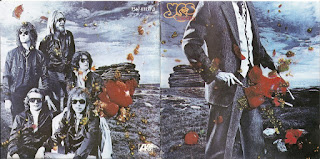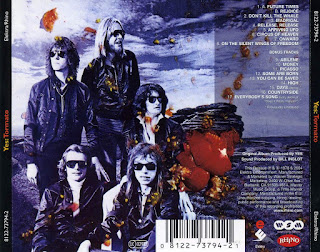Tormato is the ninth studio album by the English rock band Yes, released on 22 September 1978 by Atlantic Records. It is their last album recorded with singer Jon Anderson and keyboardist Rick Wakeman prior to their departure from the group in 1980. After wrapping their tour in support of their previous album, Going for the One (1977), the band gathered in London in February 1978 to record a new album. The band encountered several issues that hindered its potential including their overall direction, the decision to produce it by themselves, and its uneven quality.
Tormato received a mixed critical reception upon release, but was a commercial success. It peaked at No. 8 in the UK and No. 10 in the US. "Don't Kill the Whale" was released as a single in the UK which reached No. 36. Tormato continued to sell in the US and is certified platinum by the Recording Industry Association of America for selling over one million copies. Yes supported the album with the commercially successful 1978–79 tour with concerts performed in the round. Tormato was remastered for CD in 1994 and 2004; the latter contains several previously unreleased tracks from the album's recording sessions.
In December 1977, the Yes line-up of singer Jon Anderson, bassist Chris Squire, guitarist Steve Howe, drummer Alan White, and keyboardist Rick Wakeman, wrapped their 1977 tour of North America and Europe in support of their eighth album, Going for the One (1977). The album marked a return to commercial success after it went to number one in the UK for two weeks and spawned a UK top-10 single in "Wonderous Stories". The 84-date tour was considerably taxing on the group, and they took a break at its conclusion before they reconvened at Sound Associates in Queensway, London in mid-February 1978 to write and rehearse material for a new studio album.
Tormato was recorded from February to June 1978, and is the band's first recorded in two different London studios, Advision Studios in Fitzrovia and RAK Studios in Regent's Park. Initially they were split where the recording should take place; Howe and Squire wished to stay in London and suggested somewhere "warm and comfortable and easy", while others preferred to return to Switzerland where they had recorded Going for the One. The early studio sessions saw the return of Eddie Offord working with the band as their engineer and producer since Relayer (1974), but his involvement came to an end soon after. Left without a producer, the band decided to produce and mix the album themselves and hired Geoff Young and Nigel Luby, who had assisted with the production of Going for the One, as the engineers. This way of working caused internal issues as Wakeman recalled: "No one was afraid to say, 'Well, Jon, I think you should sing this part.' Or 'Steve, that's a bad guitar part.' Tempers got frayed." Howe agreed with the view, and believed such tensions affected the album's sound quality and tone as a result. By the end of the recording sessions, Yes had recorded enough material to fit on one and a half albums. Tormato was released with eight tracks, the highest number on a Yes studio album since Time and a Word (1970).
The album features the band playing new instruments that were not used on previous Yes albums. By the time of recording, Wakeman had changed his keyboard rig to incorporate the Polymoog, a polyphonic analog synthesiser which he said was used mainly for "soloing and filling", and the Birotron, a tape relay keyboard which he had co-funded during its development and manufacturing since four years earlier. Wakeman reduced the number of keyboards he typically used so the tracks could relate to each other, thus creating an album that "flowed a bit more". Looking back on the album a year after its release, Wakeman admitted he got it "60 percent right and 40 percent wrong", and wished he played things differently. One of Howe's criticisms of Tormato was that the Polymoog and Birotron did not compliment his guitar sound and noted they often "cancel each other out". Howe picked out "Madrigal", "Release, Release", and "On the Silent Wings of Freedom" as the tracks he liked best.
As with Going for the One, the album's cover was designed by Hipgnosis but retains the band's logo designed by Roger Dean. Howe pitched the album's original title of Yes Tor, referring to Yes Tor, the second highest hill on Dartmoor, an area of moorland in Devon, England. Wakeman claimed to have thrown a tomato at the pictures taken for the album as he recalled the band were disappointed with the initial artwork which had cost a lot of money. The album's title and cover was changed accordingly. Wakeman said the album became a "tragedy" as it had poor artwork and production, but good music. Howe said it was someone at Hipgnosis who threw the tomato on purpose, something that he felt insulted about. According to White, the band "couldn't decide on the cover. I think Po ... put a picture of a guy with divining sticks on the front. He took it home one night and decided it wasn't working. So he threw a tomato at it".
The sleeve includes a photograph of the band that was taken in Regent's Park, London, with each member wearing a bomber jacket and sunglasses and looking in a different direction. Each jacket was labelled with the member's name on the front, but Squire had forgotten his and had to wear one labelled "Jim", belonging to tour manager Jim Halley. The word "Chris" was then drawn onto the final cover.
Tormato was released on 22 September 1978, reaching number 8 on the UK Albums Chart and number 10 on the US Billboard 200. "Don't Kill the Whale" was released as a single in September 1978 and peaked at number 36 in the UK singles chart. It became the band's first album to be certified Platinum by the Recording Industry Association of America.



















No hay comentarios.:
Publicar un comentario